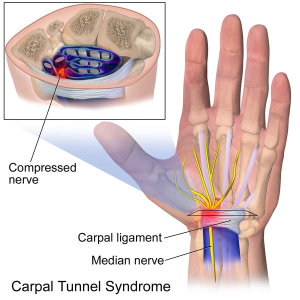 Carpal tunnel syndrome (CTS) is brought on by increased pressure on the median nerve at the wrist. The carpal tunnel is a passageway in the wrist formed by the eight carpal wrist bones which make up the floor and sides of the tunnel and the very strong transverse carpal ligament which stretches across the roof of the tunnel. Inside the carpal tunnel are nine tendons and the median nerve. CTS occurs when pressure builds up from swelling in this already very tight tunnel and puts even more pressure on the nerve. When the pressure from swelling becomes great enough to disturb the way the nerve functions, numbness, tingling and pain are often felt in the hand and fingers.
Carpal tunnel syndrome (CTS) is brought on by increased pressure on the median nerve at the wrist. The carpal tunnel is a passageway in the wrist formed by the eight carpal wrist bones which make up the floor and sides of the tunnel and the very strong transverse carpal ligament which stretches across the roof of the tunnel. Inside the carpal tunnel are nine tendons and the median nerve. CTS occurs when pressure builds up from swelling in this already very tight tunnel and puts even more pressure on the nerve. When the pressure from swelling becomes great enough to disturb the way the nerve functions, numbness, tingling and pain are often felt in the hand and fingers.
Causes
Usually the cause is unknown, but a variety of problems can contribute to compression of the median nerve:
- swelling of the flexor tendon lining, called tenosynovitis
- acute wrist fractures and dislocation
- osteo- and rheumatoid arthritis, which can narrow the tunnel
- fluid retention, as in pregnancy
- crush injuries
- diabetes
- obesity
- tumors and tumor-like conditions
- hypothyroidism
- keeping the wrist bent for long periods of time, especially while asleep or riding a bike
Signs and Symptoms
Carpal tunnel syndrome symptoms usually include a combination of pain, numbness and tingling in the thumb, index, middle and radial side of the ring finger. Many patients experience these symptoms during the night, in which they simply shake out their hands or dangle them over the bed to help “wake up” the asleep nerve. Numbness, tingling and wrist pain may also be noticed during daily activities such as driving, holding a cell phone, bike riding or reading a newspaper.
In more advanced cases of CTS, patients notice weaker grip strength and have a tendency to drop things. In severe, chronic cases of CTS, sensation may be permanently lost and the thenar muscles at the base of the thumb slowly atrophy, causing difficulty with pinch and grip. These are serious, late symptoms that need immediate treatment.
Diagnosis
A detailed history including what the patient does to alleviate their symptoms, medical conditions, how the hands are used in activities of daily living, hobbies and sports, and whether there were any prior injuries in the past is important.
Examination of the hand can reveal thenar atrophy from chronic CTS, weakness in grip and pinch strength and numbness in the thumb, index, middle and radial side of the ring finger (median nerve distribution). Phalen’s test is performed by gently flexing the wrist, then holding this position and waiting for symptoms to arise. A positive test is one that results in numbness in the median nerve distribution while holding this flexed wrist position for 60 seconds or less. The faster the numbness occurs, the more severe the CTS. Tinel’s test is performed by tapping over the wrist crease and flexor retinaculum to elicit a sensation of tingling in the median nerve distribution, which also indicates an irritated, compressed median nerve.
An x-ray will likely be taken to check for the other causes of the complaints such as arthritis or a fracture. An MRI may be obtained to show suspected tenosynovitis of the flexor tendons or a mass in the carpal tunnel. In some rare cases, Electrodiagnostic studies (NCV–nerve conduction velocities and EMG–electromyogram) may be done to confirm the diagnosis of carpal tunnel syndrome as well as to check for other possible nerve problems.
Treatment
Symptoms of mild CTS may be relieved without surgery. Diagnosing and treating medical conditions, end of pregnancy term, modifying hand use or splinting the wrist in a straight position may help reduce pressure on the nerve. Wearing wrist splints at night may help relieve pain, numbness and tingling that interfere with sleep. In cases of new-onset or mild CTS, a steroid injection into the carpal tunnel may help relieve symptoms by reducing swelling around the nerve.
When symptoms are severe and/or chronic, surgery is necessary to make more room for the nerve, otherwise the symptoms will be permanent. The goal of surgery is to free the ligament to allow more room for the median nerve in the carpal tunnel, thus restoring the blood supply to the ischemic nerve.
Dr. Viola’s surgical approach is a limited open carpal tunnel release, in which pressure on the compressed nerve is decreased by cutting the transverse carpal ligament that forms the roof of the tunnel on the palm side of the hand. The incision is typically only 1” long.
After surgery, the 4-6 strong black nylon stitches should be kept dry until they are removed at approximately two weeks post-operatively. THERE ARE NO RESTRICTIONS AFTER SURGERY. However, there may be some soreness around the incision that may last for a couple weeks or months. We do recommend basic hand therapy exercises after surgery to stretch and strengthen your hand and provide you with the best outcome possible. The numbness and tingling may disappear the same day as surgery or more slowly, depending on how long you have had CTS. It may take several months for strength in the hand and wrist to return if you have had severe carpal tunnel syndrome for several months or years, or are over the age of 40.

